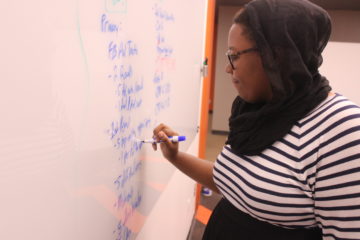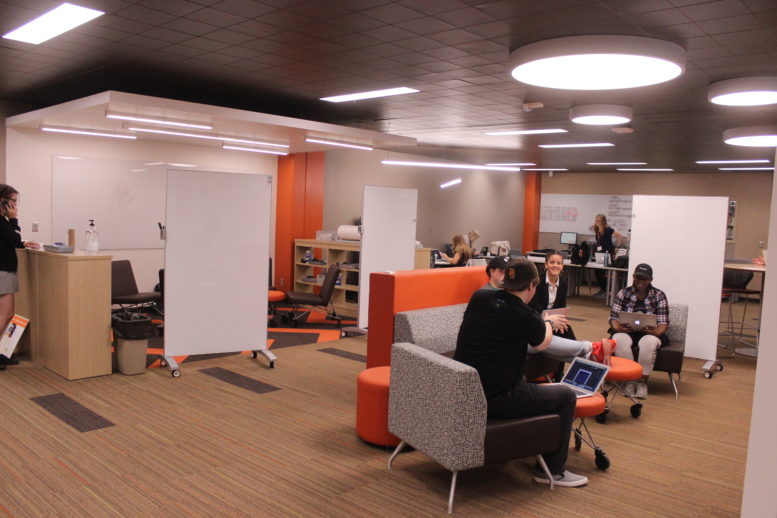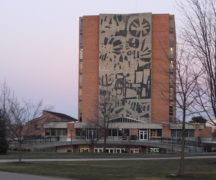By DAVID DUPONT
BG Independent News
The Collab Lab in Bowling Green State University’s Jerome Library has plenty of top notch technology—virtual reality headsets, video for 3D modeling, 3D scanner and printers, laser etchers, a suite of graphic programs, and markers.
“You never want to be out of reach of a marker and a dry erase board,” said Jerry Schnepp, the lab director.

Khadirah Hobbs works in Collab Lab in BGSU’s Jerome Library
All the high-tech equipment is ready at hand and in its place – at the periphery of the lab.
The center of the space are comfortable chairs, arranged in semi-circles, partitioned off with white boards.
Other prototyping materials are ready at hand, sheets of butcher paper, pipe cleaners, and magnets.
These humble tools are “things that will help you get your ideas out of your head and tangible,” Schnepp said.
The Collab Lab opened last week. It was funded with money from the state’s Next Frontier fund. The university received about $350,000 in state money, which it then matched. (http://bgindependentmedia.org/bgsu-taps-state-grant-to-get-ideas-flowing-at-collab-lab/)
The lab is opened to students, staff and faculty from all disciplines, Schnepp said. The idea is to foster cross-disciplinary collaborations.
The lab is also open to community members, as a way of spurring entrepreneurial ideas. The mission of the lab is not to bring innovations to fruition, but rather to germinate the ideas.
On a recent morning Emily Aquilar, of the Department of Theatre and Film faculty, was on hand with a number of her students. She directs the Treehouse Troupe. The troupe will present Dennis Foon’s “New Kid” at area elementary and middle schools this fall.
She brought her students to the Collab Lab to work on the teaching materials that will go along with the show.
Khadirah Hobbs, a marketing major, was busy working up a presentation for a client about an advertising campaign.
She said she loves the space. “I like the way it flows.” It has technology she needs. The space itself is inviting, encouraging conversation. “It has an executive feel.”
In developing the lab, Schnepp said, he drew on expertise from faculty across the university. Designing it involved the kind of collaboration the space hopes to encourage.
There were discussions of various locations for the lab before deciding on placing it on the first floor of the library. Michael Ogawa, BGSU vice president for research and economic engagement, said earlier this summer as the intellectual heart of the university, the library was the best place for the Collab Lab.
The space had been used as a computer lab and two classrooms. In developing the Collab Lab the first charge was it not look like a computer lab.
The lab employs a dozen students as digital media assistants.
Schnepp said that there’s no metric to measure the lab’s success. How the lab is used is the true test of whether it’s working. The Collab Lab aspires to be a place, he said, where “faculty and students come to work together and demonstrate that collaboration can lead to amazing innovations.”
.


